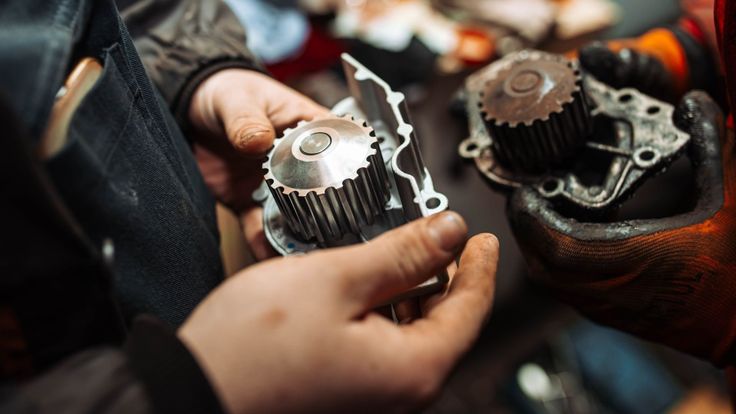Repair instructions
How Much Does a Water Pump Cost For a Car?
Overview
- The cost of replacing a car water pump typically ranges from $400 to over $1,000.
- The water pump circulates coolant through the engine and cooling system, helping to regulate engine temperature.
- Most water pumps are located at the front of the engine or within the engine block, although some are housed outside the engine.
- Common symptoms of a faulty water pump include high temperature gauge readings, warning lights, smoke or steam from under the hood, grinding sounds, and coolant leakage.
- Driving with a bad water pump is dangerous as it can cause serious engine damage.
- If you have auto repair experience, you may be able to replace the water pump yourself.
If you’ve ever been told to replace faulty parts immediately, that advice applies especially to the water pump, which is a crucial component of your car’s cooling system. But how much does it cost to replace a car water pump, and what should you expect in terms of parts and labor? Let’s dive in.

Cost of Replacing a Car Water Pump
The total cost for replacing a car water pump generally ranges from $400 to $1,000, with the pump itself typically priced between $10 and $1,600.
In addition to the water pump, you may also need to replace other components such as gaskets, pulleys, O-rings, and seals, depending on the extent of the damage. These additional parts will increase the overall cost of the replacement.
Factors Affecting the Cost of Water Pump Replacement
Several factors can influence the cost of replacing a water pump:
- Car Make and Model: Some vehicles require more complex or expensive parts and labor due to their engine design or the location of the water pump.
- Accessibility: The water pump’s location within the engine impacts the labor cost. Some pumps are easily accessible and can be replaced in a few hours, while others may require disassembling other components, increasing labor time.
- Timing Belt Removal: In certain vehicles, the timing belt obstructs access to the water pump. This means the timing belt must be removed before replacing the pump, adding additional time and labor costs.
What Is a Water Pump?
The water pump is responsible for circulating coolant through the engine and radiator, maintaining an optimal engine temperature to prevent overheating or excessive cooling. The pump also helps regulate pressure within the cooling system to prevent coolant from boiling.
A water pump uses an impeller to move a mixture of antifreeze and water through the engine block and cylinder heads. This coolant absorbs heat from the engine and carries it to the radiator, where the heat is expelled. The coolant then returns to the engine to repeat the process.
Older cars typically use mechanical water pumps driven by the engine’s drive belt, while modern vehicles often use electric water pumps powered by the vehicle’s electrical system.
Where Is the Water Pump Located?
The location of the water pump depends on the car’s engine design. Most water pumps are located at the front of the engine, usually driven by the timing belt. Some vehicles have the water pump located inside the engine block, while others feature a separate housing with hoses connecting the pump to the engine.
To access the water pump, you may need to remove the front cover or the drive belts. Your car’s service manual will provide specific details on the water pump’s location and the recommended approach to replacing it.
Signs of a Faulty Water Pump
Most modern water pumps last at least 100,000 miles, but they can fail prematurely due to wear and tear. Common signs that your water pump may be failing include:
- High readings on the temperature gauge
- Coolant warning light illumination
- Check engine light coming on
- Steam or smoke coming from under the hood
- Grinding or whining sounds from the engine
- Coolant leaking under the vehicle
Causes of Water Pump Failure
Several factors can cause erratic operation or failure of the water pump:
- A damaged impeller that can’t circulate coolant effectively
- A clogged or blocked water pump
- Loose or broken drive belts
- Worn bearings
- Faulty gaskets, hoses, seals, or tubes causing coolant leaks
- Erosion and fractures due to cavitation damage
Is It Safe to Drive with a Bad Water Pump?
No, it is not safe to drive with a bad water pump. Without a functioning water pump, the engine will not be adequately cooled, leading to overheating. This can damage other engine components, including seals that prevent coolant or oil leaks. In the worst case, the engine may fail entirely, leading to costly repairs or the need for a full engine replacement.
DIY Water Pump Replacement
If you have experience with auto repair, replacing a water pump yourself is possible. The process may vary depending on the vehicle, so it’s important to consult your service manual for the specific procedure.
Typically, you’ll need to drain the coolant, remove the drive belt, and detach the faulty water pump. After installing the new water pump, reattach the drive belt and refill the coolant reservoir with fresh coolant.
If you’re not confident in your ability to replace the water pump, it’s best to have a professional mechanic handle the job to ensure it’s done safely and correctly.
